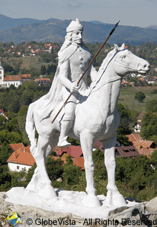Vlad the Impaler statue

Public Art: Vlad the Impaler statue
Also Known As: Vlad III statue, Vlad Dracula statue
Sculptor: © N/A
Date Unveiled: N/A
Description: A concrete statue of Vlad the Impaler otherwise known as Dracula.
Location: Club Vila Bran, Romania.
Who Was Vlad the Impaler?: Known around the world as Count Dracula, Vlad III (c1428-1477) was the second son of Vlad Dracul, ruler of Wallachia (Romania). The impaler would later become the prince of Wallachia three times. Vlad’s life was turbulent, to say the least. His father and elder brother were both murdered in 1447 during a Hungarian invasion. The instigator, John Hunyadi, placed Vlad’s second cousin, Vladislav II, as the new ruler of Wallachia. Vlad was understandably peeved. He sought refuge with the Ottomans, whilst plotting and planning to regain power in Wallachia. During his exile, he flitted between Moldavia and Hungary biding his time.
In 1456 Hungary fell out of favor with Vladislav II and in a twist, John Hunyadi, helped Vlad to invade Wallachia. In hindsight, not a very smart move. Added to the twist, Vlad was married to Hunyadi’s illegitimate daughter (make of that what you will). Vlad had developed quite a deep-seated hatred over the years and with his return to power he unleashed vengeance. Top of the list was the nobility (Wallachian boyars) who held great political power. Next were the Transylvanian Saxons, who were supporters of his uncles. Vlad went on a plundering spree, capturing people and then returning them to Wallachia where they were impaled. Thus his reputation as the Impaler, and then later Count Dracula.
For a short time, peace was restored. In 1462, however, Vlad attacked Ottoman territory. Thousands upon thousands of Turks and Bulgarians were massacred. A campaign was soon underway to replace him with his younger brother Radu. Vlad went to Transylvania to seek assistance but was imprisoned by King Corvinus. Interestingly, Vlad was now married to Corvinus’s cousin. There he dwelled for 12 years in a medieval citadel. During his imprisonment, stories about his cruelty and brutality spread. He was eventually released in 1475, having been forced to convert to Catholicism.
Vlad was eventually killed in battle around 1477.